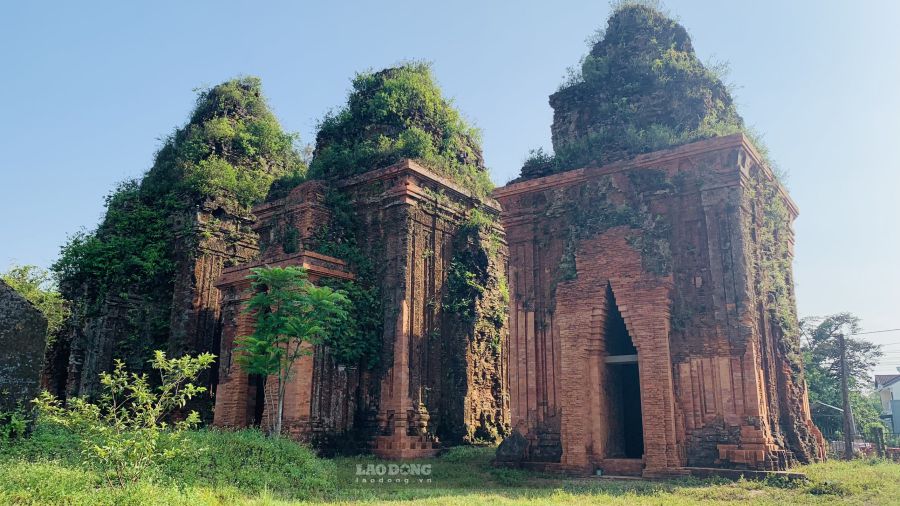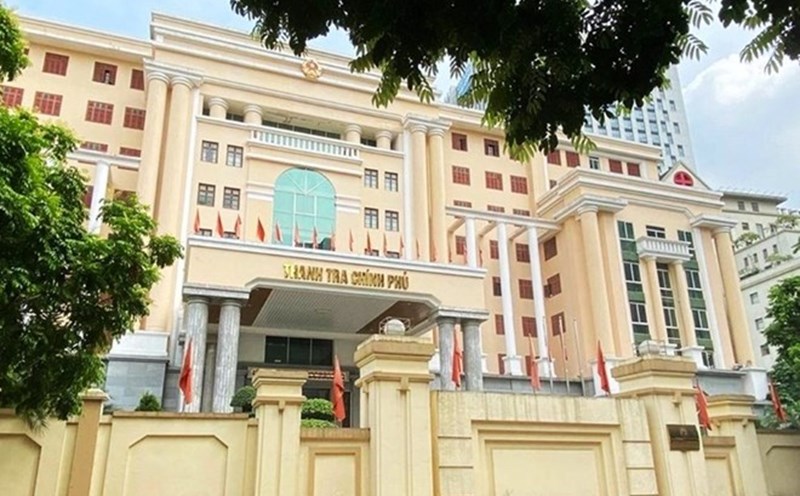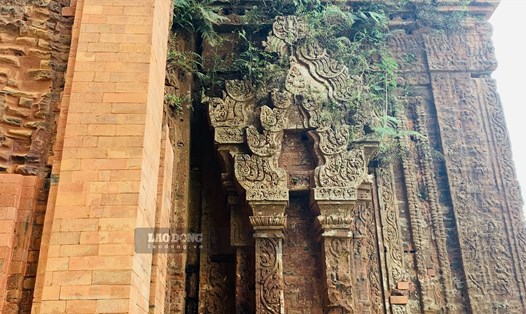Contractor says it is objective
The project "Conservation, restoration, and restoration of the North Tower and the Central Tower" of the Khuong My Tower cluster has been implemented since October 2019, with a total investment of 12.6 billion VND; the construction unit is the Institute of Construction Science and Technology (Ministry of Construction), the investor is the Quang Nam Provincial Investment and Construction Project Management Board (old). The project will be completed by the end of 2022.
After the restoration, the main hall and some damaged walls were reinforced, but just over two years later, the restored brick areas in the North Tower appeared to be Vu Vucked and peeling clearly, especially right in front of the tower entrance.
According to Lao Dong, this situation is not unique. The issue of "renovating one place, accepting a new place" in Khuong My was once questioned when the item "resorating carved details" appeared in the acceptance result announcement issued by the competent authority, while the project dossier and opinions of the Department of Cultural Heritage emphasized "not restoring patterns", and at the same time requested "protecting the intactness of existing patterns".
The investor later said it would check again, possibly a "match-ching mistake". Regardless of the explanation, the difference between documents and scenes still makes the public wondering about the quality management process in a heritage-specific project.
Meanwhile, Mr. Pham Hong Truong - Head of the Relic restoration Department, Central Center for Construction Technology Development (under the Institute of Construction Science and Technology), the construction unit - affirmed: The phenomenon of salinity leading to brick deposits is " objective", occurring in most of the Cham tower along the Central Coast; the repaired bricks have met technical requirements; "if left in the wild, the bricks will never be deposited, but if put in the tower, it will be deposited immediately"; in the long term, there is only a way to "eliminate all the salt in the tower", but this is a "very difficult and extremely expensive" solution.
According to Mr. Truong, the brick area is strongly affected mainly from the foot of the tower to about 3-3.5m - where the drought/umidity range changes greatly.
This "customer" argument continued to be raised at a meeting at the site, on March 20, 2024, chaired by the Quang Nam Department of Construction with the participation of the Department of Culture - Sports & Tourism, Department of Science & Technology, Provincial Construction Investment Project Management Board, Quang Nam Museum/ relic management center, Institute of Monuments Conservation and Institute of Construction Science and Technology.
Here, the professional report said that the soluble salt accumulates long-term in the brick - stone block combined with temperature conditions of about 32.50C and moisture of 85% to create a crystallization - recrystallization cycle, causing expansion of up to ~314% in the water-based salt phase, creating pressure in the capillary cavity, causing the brick surface to peel. The construction representative emphasized that the phenomenon occurs on both old and modified bricks and "not due to poor quality bricks".

Not salinity and not treating underground water flows are "combined" to destroy
Regarding the solution, the contractor and some opinions at the meeting proposed: Regular cleaning and surface preservation to remove crystallized salts; replace repaired bricks in the area adjacent to the old construction block with olderburnt bricks (1,000-1,0500C); extend the warranty period to 3 years; at the same time, build a regular maintenance - maintenance process after restoration. The Department of Construction concluded that it is necessary to urgently review, assess the current situation, study appropriate intervention solutions; at the same time, establish and approve maintenance procedures as a basis for future implementation.
From an independent perspective, cultural researcher Cham Le Tri Cong said that the cause of the muddy bricks after more than two years "is actually due to the salting from the old bricks to the new bricks", but the method is "completely wrong" if the basic step is to ignore the salting in the old construction block before restoration. Mr. Cong also emphasized the existence of an underground water flowing through the tower foundation - which was once surveyed for drilling and determined to be 4 - 6m deep - further increasing moisture, pulling salt onto the surface. According to him, the construction unit should have had a " foundation" solution to prevent groundwater from seeping into the tower body.
Looking more broadly, the context of Khuong My is "special" than many other Cham towers: Located about 7km from the sea by the way of the bird's nest, with water seeping down from the roof, the underground water flow right under the foundation, causing the moisture - dryness cycle to continuously take place. If the underlying cause cannot be treated (dicalging - controlling groundwater - preventing roof leakage), all surface solutions are just " modest".
In the coming time, many Cham relics such as Dong Duong Buddhist temple, Bang An tower, Chien Dan tower... will enter the conservation stage. The lesson from Khuong My is a warning about organizing environmental risk assessments (underground water, sea salt, leachate), testing materials and techniques on a small scale before mass construction, and mandating the establishment and disclosure of maintenance procedures after restoration. Only then can we avoid the "make - break - patch" loop that both wastes the budget and exhausts the value of heritage.
Lao Dong Newspaper has repeatedly reflected inadequacies in the restoration of Cham Tower, from the story of "renovating one place, accepting another" to the completed items that have deteriorated. Khuong My once again showed that if the way of making is not changed, the new bricks will continue to lose to the bricks that have stood firm for hundreds of years. And when heritage pays with fallen walls, it is impossible to just blame the weather or sea salt.








